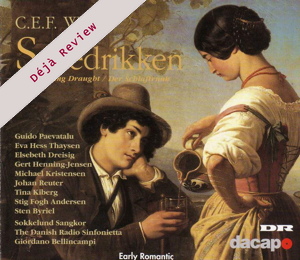
Déjà Review: this review was first published in November 2001 and the recording is still available.
Christoph Ernst Friedrich Weyse (1774-1842)
Sovedrikken (The Sleeping Draught)
Guido Paevatalu, Eva Hess Thaysen, Elsebeth Dreisig, Gert Henning-Jensen, Michael Kristensen, Johan Reuter, Tina Kilberg, Stig Fogh Andersen, Sten Byriel
Sokkelund Sangkor
Danish Radio Sinfonietta/Giordano Bellincampi
rec. 1999/2000, Danish Radio Concert Hall, Copenhagen, Denmark
Dacapo 8.224149/50 [2 CDs: 97]
This set is the first full recording of this interesting work. A few extracts have been previously released on Danacord’s Danish Songs (DACOCD348) but this composer has been largely neglected outside Denmark and hearing this work I wonder why. He clearly follows the traditions of the early German school both in structure and orchestration and a style close to Mozart or Rossini. The arias could have come from the pen of Schubert. Certainly this shows that Weyse was very knowledgeable of the music of the German and Italian masters. The composer’s background explains why this is so.
Christoph Weyse was born in Denmark, close to the German border near Hamburg. In his teens he arrived in Copenhagen as a young virtuoso pianist to live with Schulz, a composer and conductor of the Royal Theatre. The introduction to Schulz and the move had been due to the influence of professor C F Cramer of Kiel who was the son of the King Frederik V’s court chaplain. The young Weyse had visited Cramer asking for help to become a musician and so the move to Copenhagen had been the outcome.
Weyse’s early years in Copenhagen as apprentice to Schulz led to his acceptance for the post as organist in the German Reformed Church (1792) at the age of eighteen. He went on to play at court, perform piano concertos by Mozart and become a member of one of the city’s private musical clubs. During the early part of his career he wrote songs and seven symphonies (recorded under the Marco Polo label). Much of this material was recycled for use in later years, often as overtures and theatre interval music. He was a master at improvisation on the piano.
Weyse’s interest in the theatre was helped initially by Schulz and later when Kunzen replaced Schulz as conductor at the Royal Theatre. Kunzen’s wife was a singer with a wide knowledge of musical drama. On a prompt, Weyse studied Mozart and Gluck operas in detail and decided he wanted to write for the stage himself.
The score is bright, carries warm harmonies and is fast moving. In parts the orchestration is thin as if written for a chamber orchestra, which it probably was. The vocal lines carry enjoyable themes, and catchy motifs are sprinkled within the orchestration: Charlotte’s Act 1 Romance is a clear example of this fresh quality of orchestration. Surprising is Weyse’s casting of Brausse, the formidable surgeon, as a baritone rather than a more authoritative-sounding bass: to me the character is too youthful whereas Saft given the voice of a bass is rather too heavy a voice to match the feeble character. For sure, this work has been proficiently composed. It may be worth exploring Weyse’s symphonies to hear other likely specialities of composition of this forgotten composer.
The soloists sing their roles with panache. Eva Hess Thaysen and Elsebeth Dreisig sing their parts effortlessly and with pure tone. Tina Kilberg with rich timbre does justice to her part of Abelone. The men sing with clarity, but Gert Henning-Jensen (Walther, baritone) needed be a little more confident at times and his thick timbre does not always blend well in the ensemble work. In the recording the soloists are not too forwardly placed, the sound is crisp and well balanced so that every nuance of the score can be heard and does justice to the excellent playing by the Danish Radio Sinfonietta.
Praise should be handed to Danish Radio for bringing about a revival of this exciting work and recognising the importance of their heritage of past composers. (Hopefully we in Britain will eventually do the same rather than provide English translations of our continental favourites. To dust down the scores of those long lost ballad operas which Harrison and Pyne and the Carl Rosa Opera company made famous and played to packed London theatres such as Drury Lane and Royal Italian Opera at the Haymarket and Covent Garden would be of much interest and greatly appreciated.)
A first-class high-quality 172-page booklet is included with essay, notes and libretto in English, Danish, and German. This includes an interesting account of the Rise of Singspiel in Denmark around the turn of the 18th-19th Century by Jorgen Hansen. The material helps put the listener in context with the interesting background to this composition of Weyse.
Raymond Walker
Help us financially by purchasing from



















